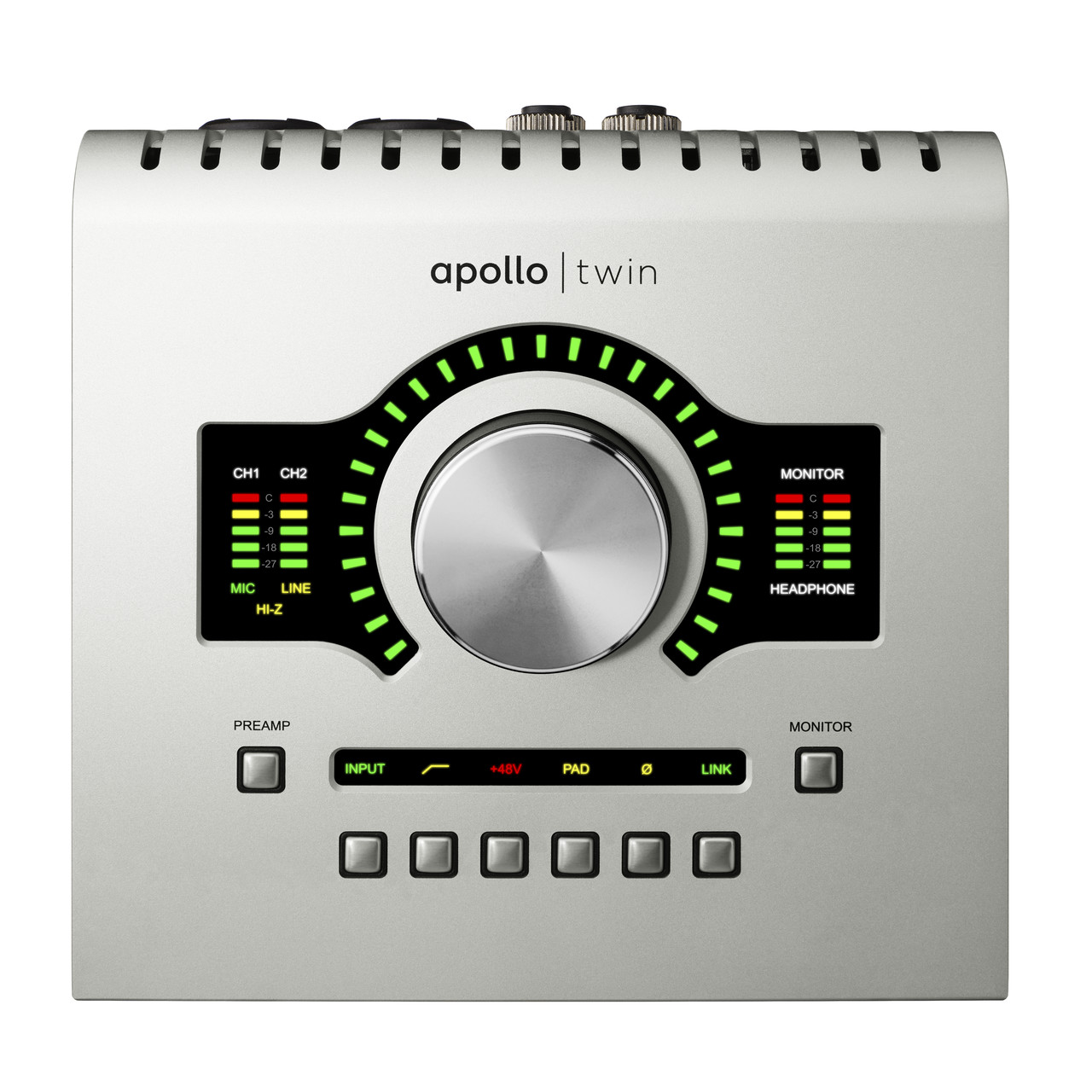 Universal Audio’s rack-mountable Apollo audio interface was an hit upon its 2012 release. Its stellar preamps, lucid design, and innovative software were perfect fits for project studios requiring great-sounding components and flexible operation, but not a vast number of preamps. (The original Apollo has four, plus additional analog and digital line inputs.)
Universal Audio’s rack-mountable Apollo audio interface was an hit upon its 2012 release. Its stellar preamps, lucid design, and innovative software were perfect fits for project studios requiring great-sounding components and flexible operation, but not a vast number of preamps. (The original Apollo has four, plus additional analog and digital line inputs.)
I was an early adopter—Apollo replaced two more cumbersome systems in my home studio. Two years later I have nothing but praise for the device. My only beef: I wanted a smaller version for mobile work.
Now it’s here. The Apollo Twin is a 6"x6"x2" tabletop unit offering many of its big brother’s best features in a gig-friendly format. It’s a remarkable tool for the digital guitarist, though it requires a recent-model Mac with a Thunderbolt port running OS 10.8 or higher, plus a DAW. (UA currently supports Logic Pro, Pro Tools, Cubase, and Live.) There is no PC-compatible version.
Model Interface The Apollo line offers more than great-sounding A/D/A conversion. It’s also a host for Universal Audio’s plug-ins, allowing you to run more plug-ins than your computer could otherwise handle. Such “assisted” hosting is increasingly unnecessary given today’s faster computers, but Universal Audio’s plug-ins are among the best in the industry. For many users, access to them is a major motive for using Apollo, especially since UA’s plug-ins only run on systems incorporating UA hardware.
The Twin comes in two versions: a dual-processor model that streets for $899 (reviewed here), and a $699 single-processor version. The larger version has twice the processing power, but beyond that, the models are identical. At risk of oversimplifying, I’d guess that the single-processor model is adequate for digital guitar gigs, but that you’d want the larger one for mixing multitrack sessions. See the usage charts on the UA website to determine which version best suits your processor needs.
UA specializes in officially licensed software versions of classic analog gear, forging deals to create software replicas of many popular studio components, including preamps, EQs, compressors, reverbs, tape simulations, effects, channel strips, and more. Their sound quality is remarkable—UA sets something of a gold standard for modeled effects. However, only a handful of plug-ins is included with an Apollo purchase, and a complete collection would cost many thousands of dollars. (All plug-ins are available for audition as fully functional, but time-limited, demos.)
Another Apollo innovation is the Console app, a virtual mixing board that not only lets you control Apollo hardware from your desktop, but also insert UA plug-ins on input channels upstream from your DAW. With its ultra-low latency, Console can duplicate the effect of recording via hardware preamps and compressors—an impressive feat. (Console only hosts plug-ins created specifically for the UA platform. Meanwhile, UA effects also appear as AU, VST, RTAS, and/or AAX plug-ins within your DAW alongside your other plug-ins.)
The Ins and Outs The Twin records at 24 bits at sample rates up to 192 kHz. It has two input channels, switchable between mic, line, and instrument level, plus the option of eight more digital inputs via optical cable. There are three sets of stereo outs: main, monitor, and headphone. You enter most values via a single large knob. There’s phantom power as needed.
The sound quality is… well, identical to that of the larger Apollo, since the Twin uses the same preamps and SHARC processors. To my sub-golden ears, the studio results are as good as or better than from any convertors I’ve owned.
The difference with my mobile laptop rig is more dramatic. I’m one of those foolhardy souls who performs live on guitar via laptop, and the Twin blows away anything I’ve used in both sound and build quality. Mind you, I’m generally amazed that under-$200 interfaces sound as decent as they do, but the Twin delivers more depth and detail than any budget model I’ve tried.
It can be hard to describe exactly how one audio interface sounds better than another—it’s not as if the cheaper ones lack highs or lows, or demonstrate obvious distortion. But with a better interface, there’s more sense of solidity. There’s just more there there.
Not Built to Break Far too many mobile interfaces are—let’s be blunt—cheap plastic pieces of crap. I’m embarrassed to confess how many I’ve destroyed through clumsy footsteps or hurried packing. (Hint: more than I can count on one hand.) And thank goodness, the Twin doesn’t have one of those horrid octopus-style breakout cables (though it does require the included 12-volt external power supply). With its rugged metal enclosure and quality connectors, the Twin is one of the few small-format interfaces that truly seems suited to the physical demands of the job.
Universal Audio Apollo uaudio.com
I’ve used the review model Twin for my last few live laptop gigs, connecting through the interface to a MacBook Pro running Apple’s MainStage software, and then back out through the Twin to a Boomerang III looper en route to a pair of Fishman LoudBoxes. My tones have more impact and a greater sense of headroom—they simply feel bigger. And it’s reassuring to have an interface on my pedalboard that seems less likely to disintegrate.
Almost Analog The Analog Classic plug-in bundle included with the Twin is modest: You get legacy editions of UA’s 1176 and LA-2A compressors, not the latest versions. There’s an underwhelming light version of Softube’s Amp Room, plus a channel strip and a reverb plug-in that are both a decade past their sell-by dates. However, the included 610-B Tube Preamp adds fine analog burn to any track—it’s perfect for inserting on a Console input channel as described above.
There’s not nearly enough room here to cover all the plug-ins UA sells separately, though I can’t resist calling out a few addictive favorites: The EMT plates are astonishingly deep and detailed recreations of those classic hardware reverbs. The simulated tape machines—a Studer multitrack and an Ampex mastering 2-track—add warmth and character to anything you run through them. You can hear those simulated devices on the audio examples included in the online version of this review.
The Verdict The Apollo Twin is a compact audio interface and plug-in host boasting remarkable sound quality and smartly streamlined features. Paired with a recent-model Mac, it’s powerful enough to anchor a busy project studio, yet compact enough to pop into your gig bag for mobile work. The bundled plug-in collection is modest, but I’d still recommend the Twin even if came with no plug-ins. It earns top marks for audio quality, workmanship, and its many useful and innovative features.
